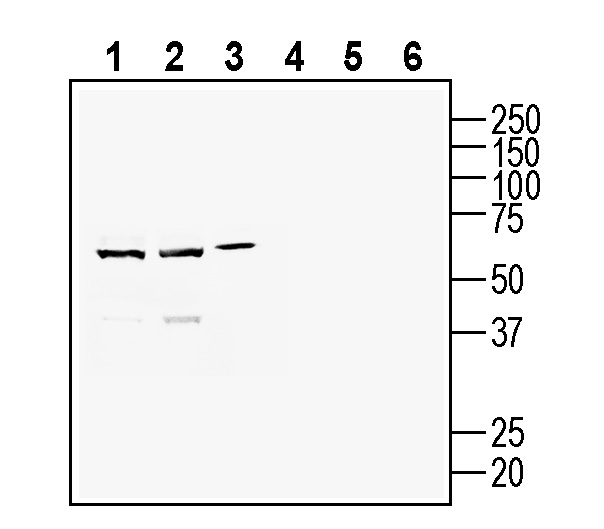Overview
- Peptide (C)KVGDFLSW(S)RQENASG, corresponding to amino acid residues 129 - 144 of mouse BST1 (Accession Q64277). Extracellular, N-terminus.
CD157/BST1 (extracellular) Blocking Peptide (#BLP-NT067)
 Western blot analysis of rat brain lysates (lanes 1 and 4), mouse brain lysates (lanes 2 and 5) and rat spleen membranes (lanes 3 and 6):1-3. Anti-CD157/BST1 (extracellular) Antibody (#ANT-067), (1:200).
Western blot analysis of rat brain lysates (lanes 1 and 4), mouse brain lysates (lanes 2 and 5) and rat spleen membranes (lanes 3 and 6):1-3. Anti-CD157/BST1 (extracellular) Antibody (#ANT-067), (1:200).
4-6. Anti-CD157/BST1 (extracellular) Antibody, preincubated with CD157/BST1 (extracellular) Blocking Peptide (BLP-NT067). Western blot analysis of mouse TK-1 T-cell lymphoma cell line lysate (lanes 1 and 4), mouse J774 macrophage cell line lysate (lanes 2 and 5) and mouse WEHI B-cell lymphoma cell line lysate (lanes 3 and 6):1-3. Anti-CD157/BST1 (extracellular) Antibody (#ANT-067), (1:200).
Western blot analysis of mouse TK-1 T-cell lymphoma cell line lysate (lanes 1 and 4), mouse J774 macrophage cell line lysate (lanes 2 and 5) and mouse WEHI B-cell lymphoma cell line lysate (lanes 3 and 6):1-3. Anti-CD157/BST1 (extracellular) Antibody (#ANT-067), (1:200).
4-6. Anti-CD157/BST1 (extracellular) Antibody, preincubated with CD157/BST1 (extracellular) Blocking Peptide (BLP-NT067).
CD157, also known as bone marrow stromal cell antigen 1 (BST1), is a glycosylphosphatidylinositol (GPI)-anchored glycoprotein with a dual function as a receptor and a β-NAD+-metabolizing ectoenzyme of the ADP-ribosyl cyclases gene family1.
CD157 and its paralog CD38, catalyze the formation of cyclic ADP-ribose (cADPR) from NAD, a second messenger involved in intracellular calcium mobilization through ryanodine receptors, among other functions 1,2.
As a receptor, CD157 interacts with β1 and β2 integrins (CD29 and CD18 respectively) to form a multimolecular complex that mediates intracellular signaling through the FAK/Src pathway 1-3. Known ligands for CD157 include extracellular matrix components like fibronectin, fibrinogen, laminin-1 and type 1 collagen 2,3.
As it name suggests, CD157 was first identified in bone marrow-derived cells, but it is also expressed in other immune system cells like neutrophils, T-cells, pre B-cells and macrophages. CD157 has been demonstrated to be involved in both the innate and adaptive immune response with roles in B- and T-cell growth and the control of myeloid cells migration during inflammation 1.
CD157 is considered a marker and therapeutic target for several hematological malignancies like acute myeloid leukemia (AML) as well as several solid tumors like ovarian and malignant mesothelioma 3,4,5.
Outside the immune system, CD157 is expressed in vascular endothelium, intestine and brain among others. Interestingly, CD157, has been identified as a risk factor for neurodegenerative diseases, particularly Parkinson's disease 2,6. The exact role of CD157 in the nervous system is not clear, but it appears to have a role in neurogenesis and neural stem cells proliferation, as well as a role in neuroinflammation probably through its association with CD18 and CD11b 2,7.
Finally, studies with CD157 knockout mice, reveal its involvement in depression-like behaviors, social avoidance and anxiety disorders 2,8.

